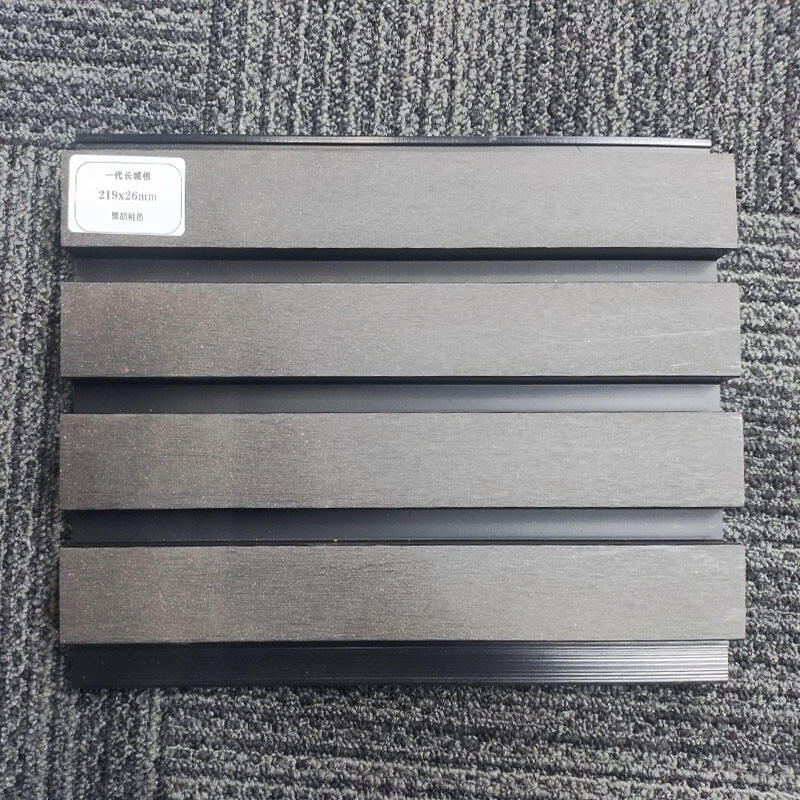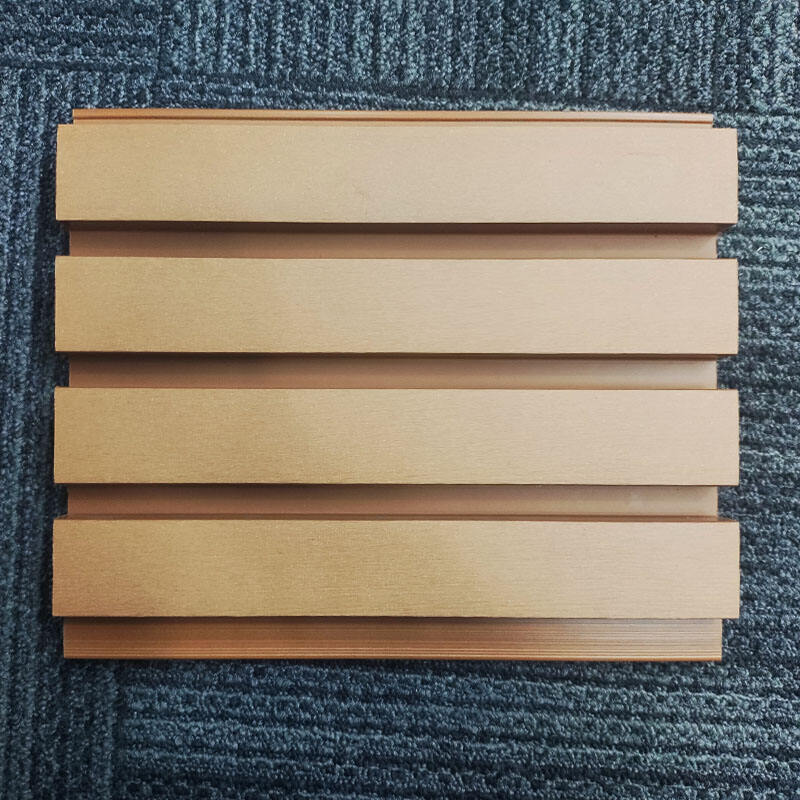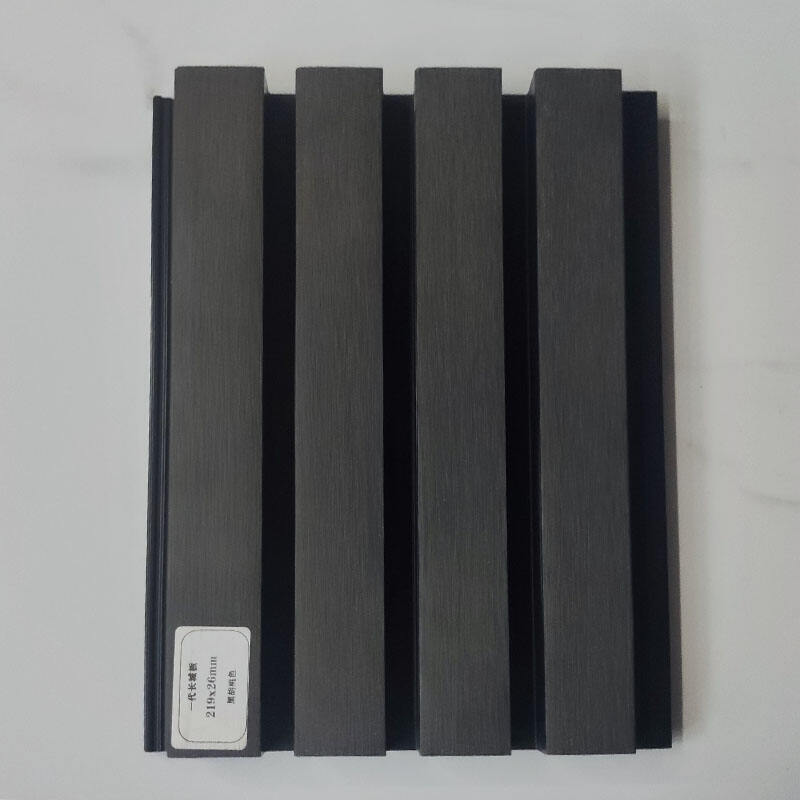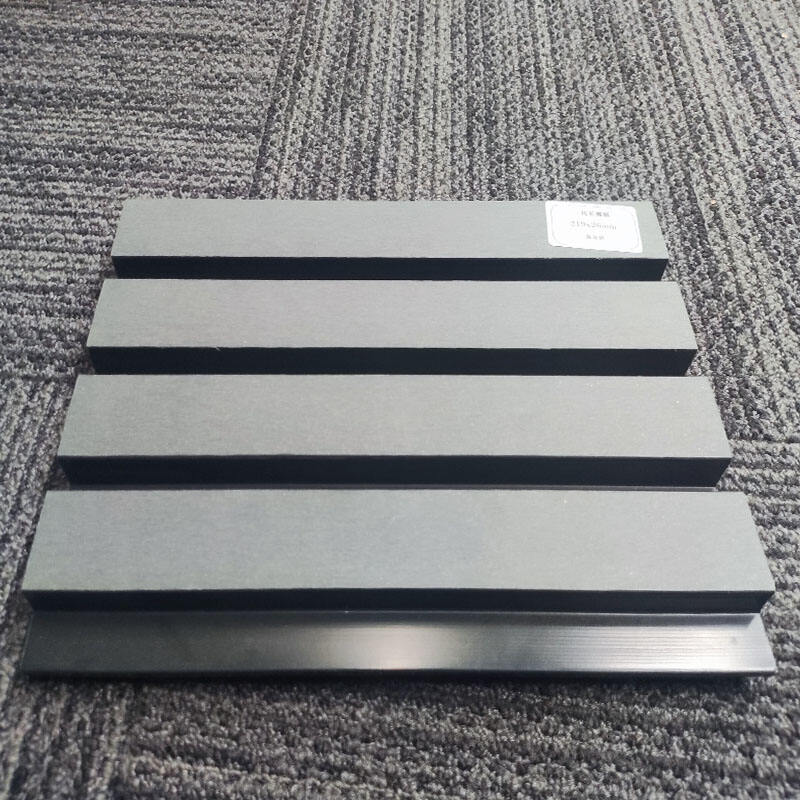উপাদানের টিকানো এবং পারফরম্যান্স
চার্জিং শর্তে আবহাওয়ার প্রতিরোধ
কঠোর পরিস্থিতিতে টিকে থাকার বেলায় ডাবলি প্যানেল প্রকৃতপক্ষে এদের দক্ষতা প্রকাশ পায়। এগুলো প্রকৃতির সব রকম আঘাত সহ্য করার জন্য তৈরি করা হয়েছে— বৃষ্টি, তুষার, এমনকি সূর্য থেকে আগত কঠোর ইউভি রশ্মি পর্যন্ত। এই প্যানেলগুলো যেভাবে তৈরি করা হয়েছে তাতে বছরের পর বছর ধরে এদের উপরের চেহারা এবং কার্যকারিতা বজায় রাখা যায় এবং এগুলো বিকৃত হয় না বা ক্ষতিগ্রস্ত হয় না। অধিকাংশ প্রস্তুতকারক এটি প্রমাণ করে দেখান শক্তিশালী পরীক্ষার ফলাফলের মাধ্যমে যা দেখায় যে আবহাওয়ার মুখোমুখি হওয়ার বেলায় WPC সাধারণ উপকরণের তুলনায় কতটা ভালো পারফর্ম করে। প্রকৃতপক্ষে প্রস্তুতকালীন সময়ে কোম্পানিগুলো WPC এর সূত্রে বিশেষ যোজক মিশ্রিত করে থাকে, যা রঙ হারানো এবং পৃষ্ঠের ক্ষতি থেকে অতিরিক্ত সুরক্ষা প্রদান করে। এই প্রকৌশল এবং বাস্তব পারফর্মেন্সের সমন্বয়ে WPC প্যানেলগুলো স্থায়ী বহিরঙ্গ স্থায়িত্বের দিক থেকে যে কোনও প্রকল্পের জন্য দরকারি হয়ে ওঠে।
কীট এবং পচনের প্রতিরোধ
WPC প্যানেলগুলি উল্লেখযোগ্য কারণ তারা সাধারণ কাঠের মতো কীটপতঙ্গকে আকর্ষণ করে না বা পচা থেকে ভোগে না। প্রাকৃতিক কাঠ সবসময়ই বিরক্তিকর টার্মিট এবং অন্যান্য কাঠ ধ্বংসকারীদের কাছে একটি চুম্বক ছিল, কিন্তু WPCগুলি শুরু থেকেই এই সমস্যাগুলির প্রতিরোধের জন্য নির্মিত। তাদের মসৃণ পৃষ্ঠতা আর্দ্রতা ধরে রাখে না, তাই তাদের উপর ক্ষয় বা ছত্রাকের সম্ভাবনা কম। আমরা অনেকগুলো ইনস্টলেশন দেখেছি যেখানে পোকামাকড় ঘুরতে পছন্দ করে, এবং বছর পার হয়ে যাওয়ার পরেও, এই WPC কাঠামোগুলো নিয়মিত মেরামতের প্রয়োজন ছাড়াই দেখতে খুব সুন্দর। শেষ কথা? গ্রাহকরা এমন কিছু পান যা দীর্ঘস্থায়ী হয় এবং রাস্তার নীচে মেরামত করার জন্য অর্থ সাশ্রয় করে, বিশেষ করে যখন ভিজা অঞ্চল বা অন্যান্য আর্দ্র পরিবেশের কাছাকাছি অবস্থিত বিল্ডিংগুলির সাথে কাজ করা হয় যেখানে কাঠ সাধারণত কয়েক মাসের মধ্যে ভেঙে যায়।


দীর্ঘমেয়াদী স্ট্রাকচারাল পূর্ণতা
WPC প্যানেলের একটি প্রধান সুবিধা হল যে তারা তাদের আকৃতি বা শক্তি হারানো ছাড়া সময়ের সাথে সাথে কতটা ভালভাবে ধরে রাখে। এই প্যানেলগুলি শক্ত এবং ভাল টান শক্তির সাথে নির্মিত যাতে তারা ভারী বোঝার শিকার হলেও বিচ্ছিন্ন বা ফাটল তৈরি করে না। তারা বছরের পর বছর ধরে সঠিকভাবে কাজ করার সময় সুন্দর দেখায়। গবেষণায় দেখা গেছে যে নিয়মিত যত্ন এবং মনোযোগ দিয়ে, WPC প্যানেলগুলি গুরুতর সমস্যা ছাড়াই 20+ বছর ধরে স্থায়ী হতে পারে, যা দীর্ঘমেয়াদে তাদের প্রাথমিক ব্যয়কে মূল্যবান করে তোলে। এই প্যানেল বিক্রি করে বেশিরভাগ কোম্পানি তাদের দাবিগুলোকে ১৫ থেকে ২৫ বছরের মধ্যে স্থায়ী গ্যারান্টি দিয়ে সমর্থন করে। যেহেতু নির্মাতারা এই ধরনের দীর্ঘ গ্যারান্টি প্রদান করে, তাই পণ্যের গুণমানের প্রতি তাদের বিশ্বাসের কথা অনেক কথাই বলে। বাড়ি মালিক এবং নির্মাতারা একইভাবে এই স্থায়িত্বের কারণ থেকে বাস্তব মূল্য পান, বিশেষ করে রাস্তার অন্য উপকরণগুলির প্রতিস্থাপনের খরচ বিবেচনা করে।
ডিজাইনের বহুমুখীতা এবং আনুষ্ঠানিক আকর্ষণ
রং এবং টেক্সচারের পরিসর
WPC প্যানেলগুলি প্রচুর রঙ এবং সমাপ্তিতে আসে যা প্রায় যে কোন স্টাইলের সাথে মিলে যায়, যা কেউ চাইতে পারে, ক্লাসিক চেহারা থেকে সম্পূর্ণ আধুনিক ডিজাইনের দিকে। নির্মাতারা এই প্যানেলগুলোকে বাস্তব কাঠের দানা মত দেখতে বা আধুনিক কাঠামো তৈরি করতে খুব ভালো করে। বিভিন্নতা অবশ্যই জায়গাটিকে দৃষ্টিভঙ্গি থেকে আরও ভাল করে তোলে, কিন্তু এটি অভ্যন্তরীণ এবং বহিরাগত উভয় ক্ষেত্রেই নকশা করার সময় বিভিন্ন ধরণের সম্ভাবনাও উন্মুক্ত করে। বাগানের পথ, ডেকের পৃষ্ঠ, এমনকি বাথরুমের দেয়ালগুলি আবহাওয়ার ক্ষতি বা রক্ষণাবেক্ষণের মাথাব্যথা নিয়ে চিন্তা না করে একই উচ্চমানের সমাপ্তি পেতে পারে।
আধুনিক স্থাপত্যের জন্য কাস্টমাইজেশন
ডাব্লুপিসি প্যানেলগুলি উল্লেখযোগ্য কারণ তারা সমসাময়িক বিল্ডিং প্রকল্পগুলিতে খুব ভাল কাজ করে। এই প্যানেলগুলোকে বিশেষ করে তোলে তা হল যে, সাইটের প্রয়োজনীয়তা অনুযায়ী সেগুলোকে কাস্টমাইজ করা কত সহজ। স্থপতিরা এটা পছন্দ করে কারণ তারা তাদের দৃষ্টিভঙ্গির সাথে ঠিক যা মিলে যায় তা পেতে পারে, তা হোক অস্বাভাবিক আকার, বিশেষ আকার, অথবা বিভিন্ন উপকরণ এক প্যানেল ডিজাইনে একত্রিত করা। অনেক নির্মাতারা লক্ষ্য করেছেন যে ডাব্লুপিসিগুলি বিভিন্ন অবস্থার তুলনায় ঐতিহ্যগত বিকল্পগুলির চেয়ে ভালভাবে পরিচালনা করে এবং উপকূলীয় অঞ্চল থেকে শহুরে ল্যান্ডস্কেপ পর্যন্ত যে কোনও পরিবেশে দুর্দান্ত দেখায়। বাস্তব সুবিধা আসে যখন স্পেসিফিকেশনগুলি প্রকল্পের মাঝামাঝি সময়ে পরিবর্তিত হয় কারণ প্রচলিত উপকরণগুলির তুলনায় সামঞ্জস্যগুলি অনেক সহজ।
ঐতিহ্যবাহী কাঠের ফিনিশ অনুকরণ
ডাব্লুপিসি প্যানেলগুলি নিয়মিত রক্ষণাবেক্ষণের ঝামেলা ছাড়াই বাস্তব কাঠের মতো দেখতে দুর্দান্ত কাজ করে, যা তাদের অনেক অ্যাপ্লিকেশনের জন্য একটি ভাল সবুজ বিকল্প করে তোলে। এই প্যানেলগুলো প্রাকৃতিক কাঠের দানা এবং গঠনকে খুব ভালোভাবে কপি করে, এই কাঠের অনন্তকালীন চেহারা ধরে রাখে, যা মানুষ এত পছন্দ করে, কিন্তু আসলে এগুলো তৈরি হয়েছে যৌগিক উপকরণ থেকে যা বেশি দিন স্থায়ী হয়। গবেষণায় দেখা গেছে যে বেশিরভাগ মানুষ এই পথটি বেছে নেয় যখন তারা কাঠের ব্যবহারের জন্য ঐতিহ্যগতভাবে ব্যবহৃত স্থানগুলি নির্মাণ বা সংস্কার করে। অনেক বাড়ির মালিকরা এই প্যানেলগুলি বিশেষ করে ডেক এবং প্যাটিওর মতো বাইরের জায়গাগুলিতে ভাল কাজ করে যেখানে সাধারণ কাঠের জন্য ক্রমাগত পেইন্টিং বা সিলিংয়ের প্রয়োজন হয়।
সংক্ষেপে, WPC প্যানেলগুলির ডিজাইনের বহুমুখী ব্যবহার এবং দৃষ্টিনন্দন আকর্ষণ তুলনাহীন, যা সৃজনশীল স্বাধীনতা দেয় এবং দীর্ঘস্থায়ী হওয়া নিশ্চিত করে। যেটি আধুনিক চেহারা বা ঐতিহ্যবাহী আকর্ষণের লক্ষ্যে থাকুক না কেন, WPC প্যানেলগুলি বাণিজ্যিক এবং আবাসিক প্রকল্প উভয়ের জন্যই প্রয়োজনীয় সমাধান সরবরাহ করে।
পরিবেশ ও অর্থনৈতিক বিবেচনা
টেকসই উৎপাদন প্রক্রিয়া
কাঠ-প্লাস্টিকের কম্পোজিট প্যানেলগুলি সবুজ উত্পাদন ক্ষেত্রে একটি বড় অগ্রগতি উপস্থাপন করে কারণ তারা মূলত পুনর্ব্যবহৃত প্লাস্টিক এবং কাঠের ফাইবার থেকে তৈরি। তাদের পরিবেশগত পদচিহ্ন ঐতিহ্যবাহী নির্মাণ সামগ্রী যেমন কঠিন কাঠ বা পিভিসি পণ্যের তুলনায় কম। ক্রমবর্ধমান সংখ্যক কোম্পানি সবুজ উৎপাদন পদ্ধতিতে পরিবর্তন করতে শুরু করেছে যা উৎপাদনকালে বর্জ্য উৎপাদন এবং সামগ্রিক শক্তি ব্যবহার উভয়ই হ্রাস করে। পুরো জীবনচক্রের মূল্যায়ন দেখে আমরা বুঝতে পারি যে এই প্যানেলগুলি সাধারণত সাধারণ কাঠের চেয়ে অনেক কম কার্বন পদচিহ্ন ফেলে। আমরা এই প্রবণতাকে ত্বরান্বিত হতে দেখছি কারণ স্থপতি এবং নির্মাতারা তাদের প্রকল্পে টেকসই উন্নয়নের প্রতি ক্রমবর্ধমান গুরুত্ব দিচ্ছেন। জলবায়ু উদ্বেগ প্রতিদিনই জরুরি হয়ে উঠছে, তাই ডব্লিউপিসি প্যানেলগুলি এমন একটি উদ্ভাবন হিসেবে চিহ্নিত হয়েছে যা সময়ের সাথে সাথে আরও উন্নত হচ্ছে।
পণ্য আয়ুষ্কালের ওপর খরচের তুলনা
সাধারণ উপকরণগুলোর তুলনায় WPC প্যানেলের দাম অনেক বেশি, কিন্তু সময়ের সাথে সাথে তারা যা সঞ্চয় করে তা দেখলে সমীকরণটা বদলে যায়। সত্য হচ্ছে এই কম্পোজিট প্যানেলগুলোতে খুব বেশি রক্ষণাবেক্ষণের প্রয়োজন হয় না, যার মানে সম্পত্তি মালিকরা রাস্তার নিচে জিনিসগুলি ঠিক করার জন্য অনেক কম অর্থ ব্যয় করে। যখন আমরা প্রায় বিশ বছরের সংখ্যাগুলি দেখি, তখন অধিকাংশ গবেষণায় মেরামত বিল এবং প্রতিস্থাপন খরচ ব্যাপক হ্রাস দেখায়। এজন্যই এই ব্যবসায়ের অনেক মানুষ এই দিনগুলোতে WPC-তে ফিরে আসছে। ঠিকাদাররাও ভালোবাসেন যে তারা আবহাওয়ার ক্ষতির বিরুদ্ধে কত দীর্ঘস্থায়ী। স্থপতি এবং নির্মাতারা তাদের আরো প্রায়ই নির্দিষ্ট করতে শুরু করেছে কারণ কেউই ধ্রুবক রক্ষণাবেক্ষণের সাথে মোকাবিলা করতে চায় না যখন আরও ভাল বিকল্প পাওয়া যায় যা ব্যাংক ভাঙার ছাড়াই সময়ের পরীক্ষায় দাঁড়ায়।
কম রক্ষণাবেক্ষণের প্রয়োজন
ডব্লিউপিসি প্যানেলের একটি বড় সুবিধা হল এদের প্রতি কম রক্ষণাবেক্ষণের প্রয়োজন হয়, যেখানে সাধারণ কাঠ পচে যায়, ভেঙে যায় এবং নিয়মিত সীল করা ও রং করার প্রয়োজন হয়। সম্পত্তি পরিচালকদের জন্য এটি খুব সুবিধাজনক কারণ এটি রক্ষণাবেক্ষণের জন্য অনেক সময় ও অর্থ বাঁচায়, বিশেষ করে ব্যস্ত বাণিজ্যিক পরিবেশে যেখানে কারও কাছে অতিরিক্ত সময় থাকে না। বাস্তব অভিজ্ঞতা দেখায় যে ডব্লিউপিসি দিয়ে তৈরি ভবনগুলি বছরের পর বছর ধরে কোনও সংশোধনের প্রয়োজন হয় না, যা ভাড়াটিয়াদের খুশি রাখে এবং ব্যবসায়িক দৃষ্টিকোণ থেকেও যৌক্তিক। আজকাল আরও বেশি মানুষ এমন উপকরণ খুঁজছেন যার নিয়মিত যত্নের প্রয়োজন হয় না, এবং তাই দীর্ঘস্থায়ী তবে সমস্যামুক্ত পৃষ্ঠতলের জন্য ডব্লিউপিসি জনপ্রিয়তা অর্জন করছে। এ ধরনের পণ্য খুঁজতে গিয়ে কেউ কেউ হয়তো নিম্নলিখিত শব্দগুলি দেখতে পাবেন ডিকোরেটিভ ওয়াল প্যানেল , শব্দ শোষিত প্রাচীর প্যানেল, অথবা শব্দপ্রতিরোধী প্যানেল যেগুলি সবই ঐতিহ্যগত নির্মাণ উপকরণের পরিবর্তে কম যত্নসাপেক্ষ বিকল্পের অধীনে পড়ে।

অ্যাপ্লিকেশন-স্পেসিফিক সুবিধা
অভ্যন্তরীণ বনাম বহিরঙ্গন ব্যবহারের ক্ষেত্র
WPC প্যানেলগুলি খুব দরকারী কারণ তারা অভ্যন্তরীণ এবং বাইরের উভয় বিল্ডিংয়ে ভাল কাজ করে। মানুষ এগুলোকে ঘর ও অফিসের ভিতরে সজ্জিত দেয়াল হিসেবে স্থাপন করে, কিন্তু আবহাওয়া খারাপ হলে সেগুলো ডেক এবং প্যাটিওতেও বেশ বেশি দেখা যায়। আমরা দেখেছি যে, অনেক বেশি মানুষ এই প্যানেলগুলোকে বহিরঙ্গন প্রকল্পের জন্য বেছে নিয়েছে, কারণ তারা বৃষ্টি, সূর্যের ক্ষতি এবং তাপমাত্রার পরিবর্তনের চেয়ে অনেক বিকল্পের চেয়ে ভালোভাবে প্রতিরোধ করে। অভ্যন্তর ডিজাইনাররাও WPC উপাদান নিয়ে কাজ করতে পছন্দ করে। তারা জানে যে গ্রাহকরা এমন কিছু চায় যা রক্ষণাবেক্ষণের খরচ ছাড়াই ব্যাংককে ভাঙতে পারে। ঐতিহ্যগত বিকল্পগুলির তুলনায় প্যানেলগুলি বেশ সহজেই দেয়ালের সাথে লেগে থাকে, যা ইনস্টলেশনের সময় সময় সাশ্রয় করে। পারিবারিক কক্ষ থেকে শুরু করে হোটেল লবি পর্যন্ত, ডাব্লুপিসি বিভিন্ন ধরণের জায়গাগুলিতে জনপ্রিয়তা অর্জন করে চলেছে যা কার্যকরী এবং শৈলীপূর্ণ প্রাচীরের পৃষ্ঠতল প্রয়োজন।
শব্দ এবং তাপ নিরোধক বৈশিষ্ট্য
ডাব্লুপিসি উপাদান থেকে নির্মিত অ্যাকোস্টিক ওয়াল প্যানেলগুলি চমৎকার শব্দ নিরোধক ক্ষমতা সরবরাহ করে, বাড়ি এবং ব্যবসায়ের জন্য আরও ভাল পরিবেশ তৈরি করে যেখানে শব্দ নিয়ন্ত্রণ গুরুত্বপূর্ণ। এই WPC প্যানেলগুলির ভাল তাপ নিরোধক গুণাবলী রয়েছে যা সারা বছর ধরে অভ্যন্তরীণ স্থানগুলিকে আরামদায়ক তাপমাত্রায় রাখতে সহায়তা করে। এই দ্বৈত সুবিধার ফলে শক্তি সঞ্চয় বেশ উল্লেখযোগ্য হতে পারে এবং একই সাথে সবুজ বিল্ডিং অনুশীলনকে সমর্থন করে। গবেষণায় দেখা গেছে যে, WPC প্যানেল যুক্ত ভবনগুলি ঐতিহ্যবাহী উপকরণগুলির তুলনায় সামগ্রিক শক্তি খরচ ক্ষেত্রে ভাল পারফরম্যান্স করে। যে কেউ অপ্রয়োজনীয় শব্দ কমাতে এবং স্থিতিশীল অভ্যন্তরীণ জলবায়ু বজায় রাখতে চায়, এই পরিবেশ বান্ধব প্যানেলগুলি আধুনিক নির্মাণ প্রকল্পগুলির জন্য একটি স্মার্ট পছন্দ।
উচ্চ যানজনপ্রবাহ এলাকার জন্য উপযুক্ততা
WPC প্যানেলগুলো এমন জায়গায় খুব ভালো কাজ করে যেখানে অনেক মানুষ সারাদিন ঘুরে বেড়ায় কারণ সেগুলো শক্ত। স্কুল, অফিস ভবন, এবং অ্যাপার্টমেন্ট কমপ্লেক্সগুলোতে প্রায়ই এই প্যানেলগুলি স্থাপন করা হয় কারণ সাধারণ কাঠ সেখানে খুব দ্রুত ভেঙে যায়। সম্পত্তি ব্যবস্থাপকরা বলছেন যে তারা ঐতিহ্যগত উপকরণগুলির পরিবর্তে WPC-তে স্যুইচ করার সময় দেয়ালগুলি মেরামত করতে অনেক কম অর্থ ব্যয় করে। বিল্ডিং শ্রমিকরাও তাদের পছন্দ করে, বিশেষ করে করিডোর এবং সাধারণ এলাকায় যেখানে সারাদিন ধরে নিয়মিত পাদচারী চলাচল হয়। প্যানেলগুলি বছরের পর বছর ব্যবহারের পরেও পোশাকের লক্ষণ দেখা না দিয়ে চলতে থাকে, যা মেরামতের জন্য অর্থ সাশ্রয় করে এবং দীর্ঘমেয়াদে জায়গাটিকে ভাল দেখায়।

